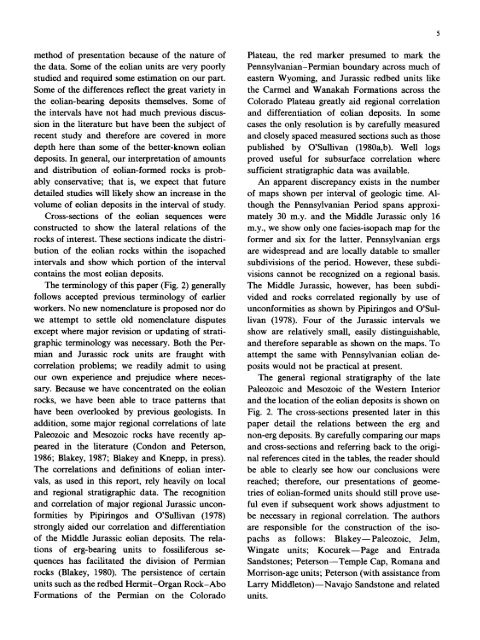Synthesis of late Paleozoic and Mesozoic eolian deposits of the ...
Synthesis of late Paleozoic and Mesozoic eolian deposits of the ...
Synthesis of late Paleozoic and Mesozoic eolian deposits of the ...
You also want an ePaper? Increase the reach of your titles
YUMPU automatically turns print PDFs into web optimized ePapers that Google loves.
method <strong>of</strong> presentation because <strong>of</strong> <strong>the</strong> nature <strong>of</strong><br />
<strong>the</strong> data. Some <strong>of</strong> <strong>the</strong> <strong>eolian</strong> units are very poorly<br />
studied <strong>and</strong> required some estimation on our part.<br />
Some <strong>of</strong> <strong>the</strong> differences reflect <strong>the</strong> great variety in<br />
<strong>the</strong> <strong>eolian</strong>-bearing <strong>deposits</strong> <strong>the</strong>mselves. Some <strong>of</strong><br />
<strong>the</strong> intervals have not had much previous discus-<br />
sion in <strong>the</strong> literature but have been <strong>the</strong> subject <strong>of</strong><br />
recent study <strong>and</strong> <strong>the</strong>refore are covered in more<br />
depth here than some <strong>of</strong> <strong>the</strong> better-known <strong>eolian</strong><br />
<strong>deposits</strong>. In general, our interpretation <strong>of</strong> amounts<br />
<strong>and</strong> distribution <strong>of</strong> <strong>eolian</strong>-formed rocks is prob-<br />
ably conservative; that is, we expect that future<br />
detailed studies will likely show an increase in <strong>the</strong><br />
volume <strong>of</strong> <strong>eolian</strong> <strong>deposits</strong> in <strong>the</strong> interval <strong>of</strong> study.<br />
Cross-sections <strong>of</strong> <strong>the</strong> <strong>eolian</strong> sequences were<br />
constructed to show <strong>the</strong> <strong>late</strong>ral relations <strong>of</strong> <strong>the</strong><br />
rocks <strong>of</strong> interest. These sections indicate <strong>the</strong> distri-<br />
bution <strong>of</strong> <strong>the</strong> <strong>eolian</strong> rocks within <strong>the</strong> isopached<br />
intervals <strong>and</strong> show which portion <strong>of</strong> <strong>the</strong> interval<br />
contains <strong>the</strong> most <strong>eolian</strong> <strong>deposits</strong>.<br />
The terminology <strong>of</strong> this paper (Fig. 2) generally<br />
follows accepted previous terminology <strong>of</strong> earlier<br />
workers. No new nomenclature is proposed nor do<br />
we attempt to settle old nomenclature disputes<br />
except where major revision or updating <strong>of</strong> strati-<br />
graphic terminology was necessary. Both <strong>the</strong> Per-<br />
mian <strong>and</strong> Jurassic rock units are fraught with<br />
correlation problems; we readily admit to using<br />
our own experience <strong>and</strong> prejudice where neces-<br />
sary. Because we have concentrated on <strong>the</strong> <strong>eolian</strong><br />
rocks, we have been able to trace patterns that<br />
have been overlooked by previous geologists. In<br />
addition, some major regional correlations <strong>of</strong> <strong>late</strong><br />
<strong>Paleozoic</strong> <strong>and</strong> <strong>Mesozoic</strong> rocks have recently ap-<br />
peared in <strong>the</strong> literature (Condon <strong>and</strong> Peterson,<br />
1986; Blakey, 1987; Blakey <strong>and</strong> Knepp, in press).<br />
The correlations <strong>and</strong> definitions <strong>of</strong> <strong>eolian</strong> inter-<br />
vals, as used in this report, rely heavily on local<br />
<strong>and</strong> regional stratigraphic data. The recognition<br />
<strong>and</strong> correlation <strong>of</strong> major regional Jurassic uncon-<br />
formities by Pipiringos <strong>and</strong> O'Sullivan (1978)<br />
strongly aided our correlation <strong>and</strong> differentiation<br />
<strong>of</strong> <strong>the</strong> Middle Jurassic <strong>eolian</strong> <strong>deposits</strong>. The rela-<br />
tions <strong>of</strong> erg-bearing units to fossiliferous se-<br />
quences has facilitated <strong>the</strong> division <strong>of</strong> Permian<br />
rocks (Blakey, 1980). The persistence <strong>of</strong> certain<br />
units such as <strong>the</strong> redbed Hermit-Organ Rock-Abo<br />
Formations <strong>of</strong> <strong>the</strong> Permian on <strong>the</strong> Colorado<br />
P<strong>late</strong>au, <strong>the</strong> red marker presumed to mark <strong>the</strong><br />
Pennsylvanian'-Permian boundary across much <strong>of</strong><br />
eastern Wyoming, <strong>and</strong> Jurassic redbed units like<br />
<strong>the</strong> Carmel <strong>and</strong> Wanakah Formations across <strong>the</strong><br />
Colorado P<strong>late</strong>au greatly aid regional correlation<br />
<strong>and</strong> differentiation <strong>of</strong> <strong>eolian</strong> <strong>deposits</strong>. In some<br />
cases <strong>the</strong> only resolution is by carefully measured<br />
<strong>and</strong> closely spaced measured sections such as those<br />
published by O'Sullivan (1980a,b). Well logs<br />
proved useful for subsurface correlation where<br />
sufficient stratigraphic data was available.<br />
An apparent discrepancy exists in <strong>the</strong> number<br />
<strong>of</strong> maps shown per interval <strong>of</strong> geologic time. Al-<br />
though <strong>the</strong> Pennsylvanian Period spans approxi-<br />
mately 30 m.y. <strong>and</strong> <strong>the</strong> Middle Jurassic only 16<br />
m.y., we show only one facies-isopach map for <strong>the</strong><br />
former <strong>and</strong> six for <strong>the</strong> latter. Pennsylvanian ergs<br />
are widespread <strong>and</strong> are locally datable to smaller<br />
subdivisions <strong>of</strong> <strong>the</strong> period. However, <strong>the</strong>se subdi-<br />
visions cannot be recognized on a regional basis.<br />
The Middle Jurassic, however, has been subdi-<br />
vided <strong>and</strong> rocks corre<strong>late</strong>d regionally by use <strong>of</strong><br />
unconformities as shown by Pipiringos <strong>and</strong> O'Sul-<br />
livan (1978). Four <strong>of</strong> <strong>the</strong> Jurassic intervals we<br />
show are relatively small, easily distinguishable,<br />
<strong>and</strong> <strong>the</strong>refore separable as shown on <strong>the</strong> maps. To<br />
attempt <strong>the</strong> same with Pennsylvanian <strong>eolian</strong> de-<br />
posits would not be practical at present.<br />
The general regional stratigraphy <strong>of</strong> <strong>the</strong> <strong>late</strong><br />
<strong>Paleozoic</strong> <strong>and</strong> <strong>Mesozoic</strong> <strong>of</strong> <strong>the</strong> Western Interior<br />
<strong>and</strong> <strong>the</strong> location <strong>of</strong> <strong>the</strong> <strong>eolian</strong> <strong>deposits</strong> is shown on<br />
Fig. 2. The cross-sections presented <strong>late</strong>r in this<br />
paper detail <strong>the</strong> relations between <strong>the</strong> erg <strong>and</strong><br />
non-erg <strong>deposits</strong>. By carefully comparing our maps<br />
<strong>and</strong> cross-sections <strong>and</strong> referring back to <strong>the</strong> origi-<br />
nal references cited in <strong>the</strong> tables, <strong>the</strong> reader should<br />
be able to clearly see how our conclusions were<br />
reached; <strong>the</strong>refore, our presentations <strong>of</strong> geome-<br />
tries <strong>of</strong> <strong>eolian</strong>-formed units should still prove use-<br />
ful even if subsequent work shows adjustment to<br />
be necessary in regional correlation. The authors<br />
are responsible for <strong>the</strong> construction <strong>of</strong> <strong>the</strong> iso-<br />
pachs as follows: Blakey--<strong>Paleozoic</strong>, Jelm,<br />
Wingate units; Kocurek--Page <strong>and</strong> Entrada<br />
S<strong>and</strong>stones; Peterson--Temple Cap, Romana <strong>and</strong><br />
Morrison-age units; Peterson (with assistance from<br />
Larry Middleton)--Navajo S<strong>and</strong>stone <strong>and</strong> re<strong>late</strong>d<br />
units.

















